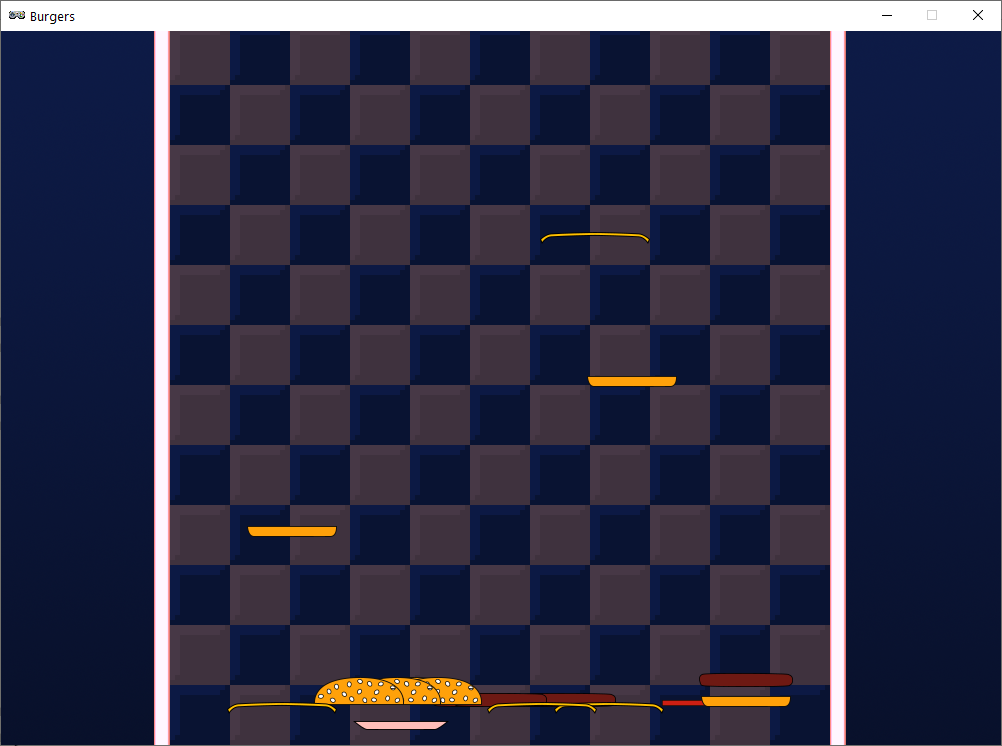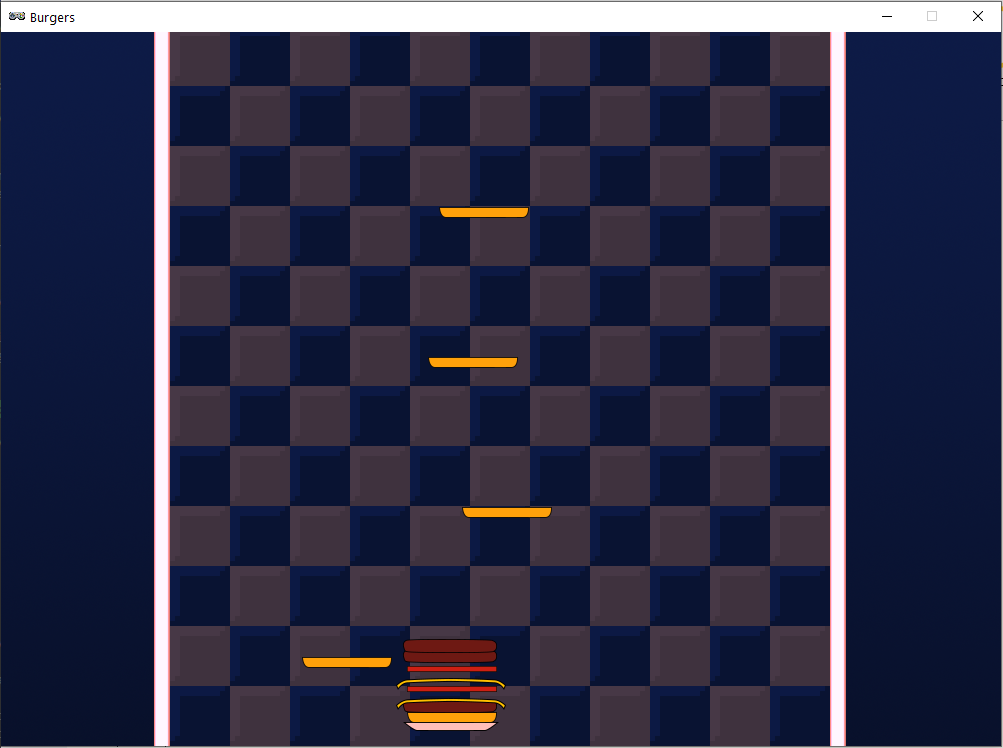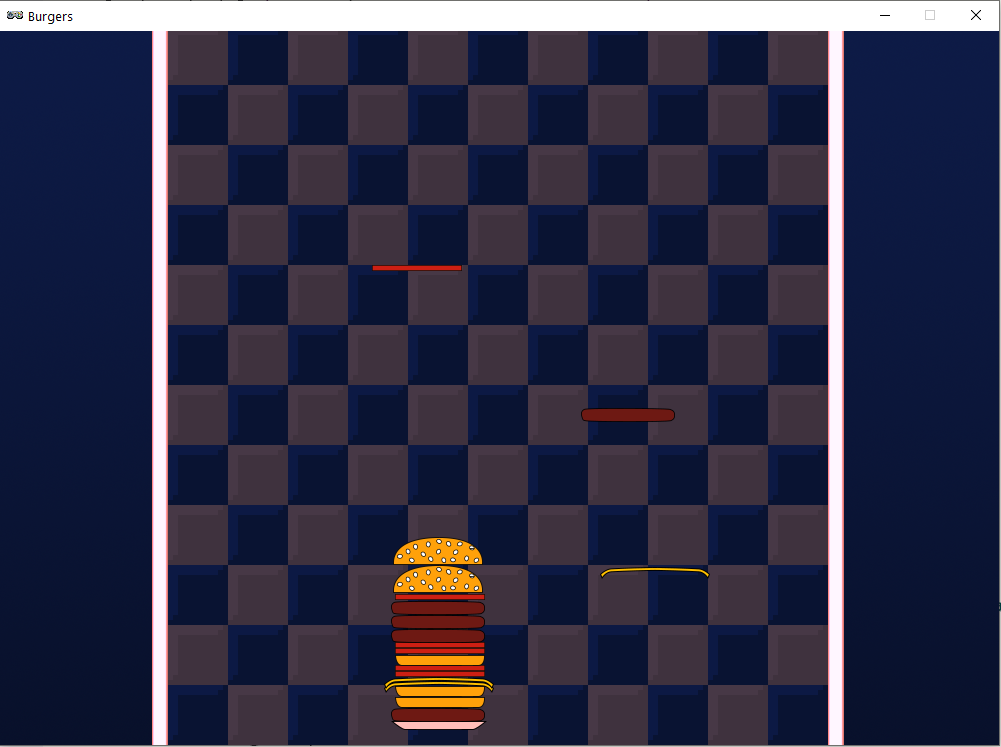Part 2¶
Tidying Up¶
Before carrying on you might want to tidy your code up a bit. It’s generally OK to reorder functions and variable definitions to make things tidier and easier to understand. Just make sure that variables and functions are defined before they are used.
The first thing your program does is execute all the lines that are not inside a function, so if a variable or function is used outside of a function then it must be defined earlier in the file.
If something is used inside a function then it has to be defined before the function is called.
Aside from some function reordering your code should look like this:
import random
TITLE = "Burgers"
WIDTH = 1000
HEIGHT = 714
SPAWN_ITEM_INTERVAL = 0.5
ITEM_X_MIN = 250
ITEM_X_MAX = 750
FALL_SPEED = 5
NUM_ITEM_TYPES = 5
item_images = ["burgers/bun_bottom",
"burgers/bun_top",
"burgers/meat",
"burgers/cheese",
"burgers/tomato"
]
class GameData:
pass
game = GameData()
def start_game():
game.items = []
clock.schedule(spawn_item, SPAWN_ITEM_INTERVAL)
def draw():
screen.blit("burgers/background",(0,0))
for item in game.items:
item.draw()
def update():
for item in list(game.items):
item.y += FALL_SPEED
def spawn_item():
item_type = random.randint(0, NUM_ITEM_TYPES-1)
new_item = Actor(item_images[item_type], (random.randint(ITEM_X_MIN, ITEM_X_MAX),100))
game.items.append(new_item)
clock.schedule(spawn_item, SPAWN_ITEM_INTERVAL)
start_game()
Two examples of correct code ordering have been highlighted in the code above:
start_gameis called outside of a function (on the last line), so the definition ofstart_gamehas to be earlier in the file. It is!spawn_itemis used inside thestart_gamefunction, so it has to be defined before thestart_gamefunction function is called. It is!
If you’re wondering about the draw and update functions, these functions are part of Pygame Zero and won’t be called until the whole file has been processed, so you can put these anywhere!
Now, let’s get on with making burgers…
Adding a Plate¶
Add these highlighted lines to create and draw the plate Actor:
It doesn’t matter if your start_game and draw functions are not in the same order as shown here. It’s just what’s inside the functions that matters.
def start_game():
game.items = []
game.plate = Actor("burgers/plate", (WIDTH/2, PLATE_Y))
clock.schedule(spawn_item, SPAWN_ITEM_INTERVAL)
def draw():
screen.blit("burgers/background",(0,0))
for item in game.items:
item.draw()
game.plate.draw()
You might have noticed that PLATE_Y doesn’t exist yet. Let’s add a few new constants to the top of the file. Just add the highlighted lines:
ITEM_X_MIN = 250
ITEM_X_MAX = 750
FALL_SPEED = 5
PLATE_Y = 690
PLATE_SPEED = 10
CATCH_RANGE_X = 40
CATCH_RANGE_Y = 20
IMAGE_SIZE = 128
Can you guess what we’ll be using these new values for? We already know what PLATE_Y is for.
You should now see your plate at the bottom of the screen ready to catch falling ingredients. It won’t move yet!
Now let’s add these highlighted lines to the beginning of your update function so we can move the plate.
def update():
if (keyboard[keys.A] or keyboard[keys.LEFT]):
game.plate.x -= PLATE_SPEED
if (keyboard[keys.D] or keyboard[keys.RIGHT]):
game.plate.x += PLATE_SPEED
if (game.plate.x < ITEM_X_MIN):
game.plate.x = ITEM_X_MIN
if (game.plate.x > ITEM_X_MAX):
game.plate.x = ITEM_X_MAX
for item in list(game.items):
item.y += FALL_SPEED
This is similar to code we’ve seen in Flappy Bird. The first two if statements handle when you press the movement keys to move the plate left and right.
Can you figure out what the last four highlighted lines do?
Catching Items¶
You should now be able to move your plate left and right. Now let’s make it so that we can catch some ingredients. The changes you need are in the highlighted lines below. You’re adding more code to the item loop in the update function. Before, this loop was moving every item down the screen. Now it’s also going to do a couple of checks on the position of the item.
The first if checks to see if the item went off the bottom of the screen (do you remember this from Flappy Bird?), and the elif checks to see if the item is near enough to the plate to be caught by it.
In both cases we remove the item from game.items. When it’s removed from the list it won’t get drawn by the draw function any more, so the item disappears!
def update():
if (keyboard[keys.A] or keyboard[keys.LEFT]):
game.plate.x -= PLATE_SPEED
if (keyboard[keys.D] or keyboard[keys.RIGHT]):
game.plate.x += PLATE_SPEED
if (game.plate.x < ITEM_X_MIN):
game.plate.x = ITEM_X_MIN
if (game.plate.x > ITEM_X_MAX):
game.plate.x = ITEM_X_MAX
for item in list(game.items):
item.y += FALL_SPEED
if (item.y > HEIGHT):
game.items.remove(item)
elif (abs(item.y - game.plate.y) < CATCH_RANGE_Y and
abs(item.x - game.plate.x) < CATCH_RANGE_X):
game.items.remove(item)
You should be able to make items disappear by hitting them with your plate.
You haven’t seen the abs function before. It means absolute and you can use it stop a number being negative. E.g.
abs(-3) gives 3abs(-100.5) gives 100.5abs(45) gives 45<– Positive numbers stay the same
Can you see why we had to use the abs function in the code we just added?
The way these lines work is by looking at how far away the plate is from an item. It checks both the x direction (left and right) and the y direction (up and down).
It uses subtraction to find the difference between two values, and because we only care about how far away it is (the absolute distance) and not whether it up or down; or left or right of the plate, we use the abs function.
The CATCH_RANGE_X and CATCH_RANGE_Y constants specify how for the item is allowed to be away from the plate in the x axis and the y axis.
See what happens if you make the catch ranges bigger like this:
PLATE_SPEED = 10
CATCH_RANGE_X = 400
CATCH_RANGE_Y = 200
IMAGE_SIZE = 128
Don’t forget to put them back:
PLATE_SPEED = 10
CATCH_RANGE_X = 40
CATCH_RANGE_Y = 20
IMAGE_SIZE = 128
Next we want these items we’ve caught to appear on the plate. We have to write some code to draw them and to make them move when the plate moves.
First we’ll create a list variable to contain items that are on the plate. Add the highlighted line:
def start_game():
game.items = []
game.plate_items = []
game.plate = Actor("burgers/plate", (WIDTH/2, PLATE_Y))
clock.schedule(spawn_item, SPAWN_ITEM_INTERVAL)
Remember that [] means an empty list.
Next let’s add every item we catch to this list. Add the highlighted line to your update function:
for item in list(game.items):
item.y += FALL_SPEED
if (item.y > HEIGHT):
game.items.remove(item)
elif (abs(item.y - game.plate.y) < CATCH_RANGE_Y and
abs(item.x - game.plate.x) < CATCH_RANGE_X):
game.items.remove(item)
game.plate_items.append(item)
Of course we also need to draw this list of items.
Can you figure out what to do to draw the items in the list?
Try to make this work on your own before scrolling down. Don’t worry that when you do draw the items they stay still and don’t move with the plate.
Here’s the solution. Add the highlighted lines to draw these items on the plate.
def draw():
screen.blit("burgers/background",(0,0))
for item in game.items:
item.draw()
game.plate.draw()
for item in game.plate_items:
item.draw()
Is this everything we need to? Try it and see if everything works…
Well, it looks like you stop items falling, but they don’t move with the plate!

We need to move these ingredient items every frame so they stay stick to the plate. Remember we can put code we want to happen every frame in the update function.
Here are some lines we can add to the end of the update function.
Beware! These lines have a bug in them! Can you spot the bug and fix it?
As a clue remember that this code is supposed to set the position of each ingredient item to match the position of the plate.
def update():
if (keyboard[keys.A] or keyboard[keys.LEFT]):
game.plate.x -= PLATE_SPEED
if (keyboard[keys.D] or keyboard[keys.RIGHT]):
game.plate.x += PLATE_SPEED
if (game.plate.x < ITEM_X_MIN):
game.plate.x = ITEM_X_MIN
if (game.plate.x > ITEM_X_MAX):
game.plate.x = ITEM_X_MAX
for item in list(game.items):
item.y += FALL_SPEED
if (item.y > HEIGHT):
game.items.remove(item)
elif (abs(item.y - game.plate.y) < CATCH_RANGE_Y and
abs(item.x - game.plate.x) < CATCH_RANGE_X):
game.items.remove(item)
game.plate_items.append(item)
game.stack_height = 0
for item in game.plate_items:
item.y = game.plate.y - game.stack_height
item.x = game.plate.y
game.stack_height += 10
|
The line that starts with item.x should be item.x = game.plate.x That's an x at the end of the line! |
What do you think the game.stack_height variable is for?
Hopefully you can now make a stack of burgers that looks something like this:

If you play with the game now you’ll probably realise we have two big problems:
Items get caught when they touch the plate. They should be caught when they hit the top of the stack.
The spacing between the items doesn’t look right. Some pieces are too close together and overlap, and some are too far apart.
Let’s fix number 1 first. Take a look at this elif statement in our update function.
The first line compares the y value (up and down), and the second line compares the x value (left and right).
elif (abs(item.y - game.plate.y) < CATCH_RANGE_Y and
abs(item.x - game.plate.x) < CATCH_RANGE_X):
So all we need to do is to change the code so that it will check if the item is close to the top of the pile instead of close to the plate. You only need to change one line.
Can you make the change to the highlighted line in the update function and figure out what needs to go in place of the __________?
Clue : It’s something we added in the previous block of code we added
elif (abs(item.y - (game.plate.y - __________)) < CATCH_RANGE_Y and
abs(item.x - game.plate.x) < CATCH_RANGE_X):
Now on to problem 2, the spacing between the ingredients in wrong. You can see the problem in the following code. We are increasing the stack_height by 10 each time:
for item in game.plate_items:
item.y = game.plate.y - game.stack_height
item.x = game.plate.x
game.stack_height += 10
The problem is that not all the ingredients have a thickness of 10 pixels. Some are thick like the meat, and some are thin like the tomato. We need to work out how thick each ingredient is and use that thickness. To save you the trouble I’ve measured the thicknesses. Add the following highlighted line near the top of your file to create a list representing the thickness of each ingredient:
item_images = ["burgers/bun_bottom",
"burgers/bun_top",
"burgers/meat",
"burgers/cheese",
"burgers/tomato"
]
item_heights = [11, 28, 14, 4, 6]
This list is in the same order as the ingredient images. You can see that bun top, in second place in both lists, is the thickest at 28 pixels, and the cheese, in 4th place in both lists is the thinnest at 4 pixels.
Now we need to add a variable to the Actor representing the falling ingredient to save what type of ingredient it actually is. Add the following highlighted line to save item_type in the new item Actor:
def spawn_item():
item_type = random.randint(0, NUM_ITEM_TYPES-1)
new_item = Actor(item_images[item_type], (random.randint(ITEM_X_MIN, ITEM_X_MAX),100))
new_item.item_type = item_type
game.items.append(new_item)
clock.schedule(spawn_item, SPAWN_ITEM_INTERVAL)
Remember that this item_type is just a number indicating which image in the list to use.
Now we can also use this item_type variable to select the correct thickness from our new list of thicknesses. The following highlighted line shows the change you need to make to the end of the update function:
for item in game.plate_items:
item.y = game.plate.y - game.stack_height
item.x = game.plate.x
game.stack_height += item_heights[item.item_type]
Now our ingredients should be stacking nicely!

Well done! There was a lot of work in this part of the tutorial. But now you have the core of the game working!
In the next part we’ll add in a scoring system so you can earn some points for your burgers.